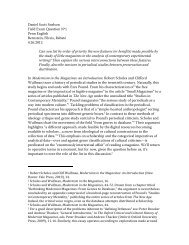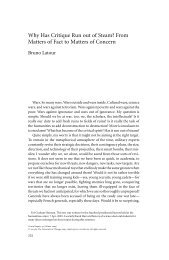The Exploit: A Theory of Networks - asounder
The Exploit: A Theory of Networks - asounder
The Exploit: A Theory of Networks - asounder
Create successful ePaper yourself
Turn your PDF publications into a flip-book with our unique Google optimized e-Paper software.
94 Nodes<br />
That is, while emerging infectious diseases and bioterrorism may<br />
have different points <strong>of</strong> origin, their resultant effects are quite similar—the<br />
processes <strong>of</strong> infection, dissemination, and propagation serve<br />
to spread both emerging infectious diseases and bioterrorist agents.<br />
For this reason, a number <strong>of</strong> earlier infectious diseases (such as smallpox<br />
or polio) have been the subject <strong>of</strong> biowarfare research.<br />
<strong>The</strong> causes may be different, but the results are the same. This should give<br />
us pause.<br />
It is not a question <strong>of</strong> mere numbers such as the number <strong>of</strong> people<br />
infected or sick—and this is not a metaphorical claim, as in the viral<br />
“meme” <strong>of</strong> anthrax. It is a point about different types <strong>of</strong> biological<br />
networks that are also more than biological. <strong>The</strong> protocol <strong>of</strong> these<br />
networks proceeds by the biological principles <strong>of</strong> epidemiology (infection<br />
rates, death and recovery rates, area <strong>of</strong> infection, etc.). But<br />
their overall organization is akin to the previous claims about computer<br />
viruses, for it is precisely the standardization <strong>of</strong> networks, along<br />
with their distributed topology, that enables an emerging infectious<br />
disease to maintain a certain level <strong>of</strong> effectiveness. <strong>The</strong> air travel industry<br />
works exceedingly well, as does the communications media<br />
network. Computer viruses and emerging infectious diseases pr<strong>of</strong>it<br />
from these modern conveniences.<br />
Both emerging infectious diseases and bioterrorism reveal the sometimes<br />
uncanny, unsettling, and distinctly nonhuman aspect <strong>of</strong> networks. <strong>The</strong>re<br />
is a defacement <strong>of</strong> enmity, but an antagonism lingers nonetheless.<br />
A single rogue may send an anthrax - tainted letter, or a single<br />
animal may be carrying a lethal virus, but one learns nothing about<br />
the network effects—and the network affect—<strong>of</strong> such diseases by<br />
focusing simply on one human subject, one viral sample, one link in<br />
the network, or the network’s supposed point <strong>of</strong> origin. Shift from or<br />
to and: it is not emerging infectious diseases or bioterrorism, but rather<br />
emerging infectious diseases and bioterrorism.<br />
Like computer viruses, emerging infectious diseases are frustratingly<br />
nonhuman.









